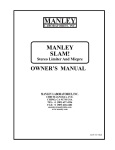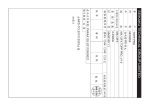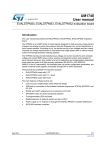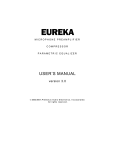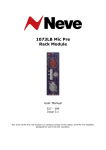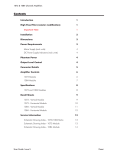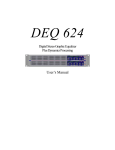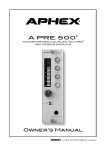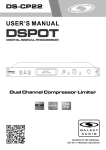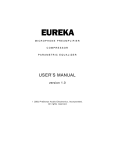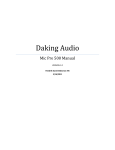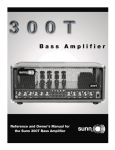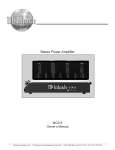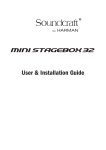Download USER`S MANUAL
Transcript
USER’S MANUAL version 1.0 © 2005, Pr e S o n u s A u d i o E l e c t r o n i c s , I n c o r p o r a t e d . A l l r i g h t s r e s e r ve d . W A R R A N T Y PreSonus Limited Warranty PreSonus Audio Electronics Inc. warrants this product to be free of defects in material and workmanship for a period of one year from the date of original retail purchase. This warranty is enforceable only by the original retail purchaser. To be protected by this warranty, the purchaser must complete and return the enclosed warranty card within 14 days of purchase. During the warranty period PreSonus shall, at its sole and absolute option, either repair or replace, free of charge, any product that proves to be defective on inspection by PreSonus or its authorized service representative. To obtain warranty service, the purchaser must first call or write PreSonus at the address and telephone number printed below to obtain a Return Authorization Number and instructions of where to return the unit for service. All inquiries must be accompanied by a description of the problem. All authorized returns must be sent to the PreSonus repair facility postage prepaid, insured and properly packaged. PreSonus reserves the right to update any unit returned for repair. PreSonus reserves the right to change or improve the design of the product at any time without prior notice. This warranty does not cover claims for damage due to abuse, neglect, alteration or attempted repair by unauthorized personnel, and is limited to failures arising during normal use that are due to defects in material or workmanship in the product. Any implied warranties, including implied warranties of merchantability and fitness for a particular purpose, are limited in duration to the length of this limited warranty. Some states do not allow limitations on how long an implied warranty lasts, so the above limitation may not apply to you. In no event will PreSonus be liable for incidental, consequential or other damages resulting from the breach of any express or implied warranty, including, among other things, damage to property, damage based on inconvenience or on loss of use of the product, and, to the extent permitted by law, damages for personal injury. Some states do not allow the exclusion of limitation of incidental or consequential damages, so the above limitation or exclusion may not apply to you. This warranty gives you specific legal rights, and you may also have other rights, which vary form state to state. This warranty only applies to products sold and used in the United States of America. For warranty information in all other countries please refer to your local distributor. PreSonus Audio Electronics, Inc. 7257 Florida Blvd. Baton Rouge, LA 70806 (225) 216-7887 (800) 750-0323 www.presonus.com © 2005, PreSonus Audio Electronics, Incorporated. All rights reserved. TABLE OF CONTENTS 1 Overview 1.1 Introduction 4 1.2 Features 5 2 Controls & Connections 2.1 Front Panel Layout 6 2.3 Back Panel Layout 8 2.4 Power and Ground 8 3 Operation 3.1 Input Sources 9 3.2 Microphones 9 3.3 Instruments 9 3.4 Line input 9 3.5 Hook up diagrams 10 1. Two Microphones 10 2. Bass Guitar (two channels) 10 3. Keyboards, Syths, Drum Machines 11 4. Stereo buss signal conditioning 11 3.6 Applications 12 1. Piano 12 2. Electric Guitar 13 3. Acoustic Guitar 14 4. Bass Guitar 15 5. Drum Overheads 16 6. Snare Drum 17 4 Technical 4.1 Block Diagram 18 4.2 Specifications 19 3 1 OVERVIEW 1.1 INTRODUCTION Thank you for purchasing the PreSonus ADL 600. The ADL 600 utilizes the highest quality components to insure optimum performance for an infinite period of time. We believe the ADL 600 to be an exceptional-sounding microphone preamplifier and an exceptional value. We encourage you to contact us at 1-800750-0323 with any questions or comments you may have regarding your PreSonus equipment. PreSonus Audio Electronics is committed to constant product improvement, and we value your suggestions highly. We believe the best way to achieve our goal of constant product improvement is by listening to the real experts, our valued customers. We appreciate the support you have shown us through the purchase of this product. Please pay close attention to how you connect your ADL 600 to your system. Improper grounding or bad cables are the most common cause of noise problems found in studio or “live” sound environments. We would like to suggest that you use this manual to familiarize yourself with the features, applications and correct connection procedure for your ADL 600 before trying to hook it up to your system. Thank you, once again, for buying our product and may we wish you good luck, and enjoy your ADL 600! 4 OVERVIEW 1.2 FEATURES The following information is a summary of your ADL 600’s features: All Tube, Dual Transformer Microphone Pre-Amplifier. Your ADL 600 is a discrete Class A high voltage all tube, dual-transformer microphone preamplifier designed for high gain (+73dB), high headroom (+30dB), low noise (-100dB S/N ratio) and ultimate sonic performance – great for all types of recording applications. • Microphone Input / Instrument Input / Line Input. Three different types of inputs are provided on the ADL 600 for maximum flexibility. You can connect microphones, instruments, keyboards as well as run your entire mix through the ADL 600 during mix-down or mastering for signal conditioning. • Variable Microphone Input Impedance. This feature enables you to “tune” your microphone – experiment with different input impedances to create different sounds from your microphones. Changing the input impedance can be the perfect solution for a given recording application. • +48 Volt Phantom Power. The ADL 600 has +48V phantom power available. This assures optimum performance of your condenser microphones that require phantom power. • -20dB PAD. A -20dB pad is available for reducing the in-coming signal level. This pad provides a more manageable signal from high output devices or extremely loud sources (drums) giving greater control over the in-coming signal to avoid clipping or distortion during recording. • Polarity Invert. Use the phase invert switch to combat phase cancellation with other open microphones. • Hi-Pass Filter. To reduce unwanted low-frequency boom, or room rumble. • VU Meter. The analog VU meter provides an accurate reading of the output level. • LED Metering. Eight segment LED meters for detecting peaks and fast transients of the output level. 5 2 CONTROLS & CONNECTIONS 2.1 FRONT PANEL LAYOUT The front panel of the ADL 600 is laid out so that if you split the front panel down the middle the controls and metering for channel 1 are on the left hand side and the controls and metering for channel 2 are on the right hand side. The following is a description of the controls for each channel: INPUT: Selects the input source (Instrument, Line, or Microphone) The microphone input has four different input impedance values to select from (1500, 900, 300 and 150 ohms). As the ADL 600’s impedance is lowered, different filtering effects can result delivering a tailored sound for a particular application. When using the Line input, the following microphone preamplifier features are bypassed: +48V, -20dB PAD and input impedance. HP FILT: Three position rotary switch to select the frequency for the HIGH PASS FILTER (40Hz, 80Hz and 120Hz). When the FILTER switch is engaged all frequencies below the selected HP FILT setting are attenuated (dropped) by 12dB. This filter can be handy in live and studio applications. For example, a high pass filter can help to reduce the “boominess” or “muddiness” of a vocal and improve the overall clarity. GAIN: Eight-position industrial grade rotary switch providing 35dB of gain in 5dB steps. TRIM: Variable potentiometer (+/-10dB) to offer fine trim adjustment to the final stage of the ADL 600. INSTRUMENT: ¼” TS connector. When an instrument is plugged into the instrument input, the microphone preamplifier is bypassed and the ADL 600 becomes an active instrument preamplifier. 6 CONTROLS & CONNECTIONS +48V: The 48 volts supplied by way of the XLR connector, provides power for condenser mics and any other devices requiring continuous phantom power through the XLR input. This power is supplied at a constant level to prevent any degradation of audio quality. XLR connector wiring for Phantom Power Pin 1= GND Pin 2= +48V Pin3= +48V POL INV: Reverses the polarity of the signal. Use the phase invert when recording with more than one open microphone to combat phase cancellation between microphones. -20dB PAD: Engaging the PAD switch provides 20dB of attenuation. This is a very useful feature for reducing the level coming into the ADL 600 and thus preventing the signal from clipping or distorting. This may occur due to high output level from a microphone or other device. Padding the input serves to provide increased “headroom” for the operator while lessening the likelihood of signal overload. HP FILTER: Engages the high pass filter set with the HP FILT control. VU METER -6dB: Decreases the VU meter by 6dB. This can help you meter loud input sources if your VU meter is “slamming” or is pegged. POWER: Turns your ADL 600 ON/OFF. 7 CONTROLS & CONNECTIONS 2.2 BACK PANEL LAYOUT Connectors All Input and Output connectors are transformer balanced. XLR with the following wiring standard: XLR PIN 1 GND PIN 2 High (+) PIN 3 Low (-) NOTE: The LINE INPUT does not pass signal unless the INPUT selector switch is set to LINE on the front panel. 2.3 POWER AND GROUND AC POWER: Your ADL 600 accepts a standard IEC cord. Note: The input power voltage is set at the factory to correspond with the country in which it was shipped.. CHASSIS GND LINK: By removing the metal strap attached by two phillips head screws, the electrical ground from the chassis is lifted. The ADL will then find a common ground. This is helpful if you hear a ground hum caused by a ground loop. 8 3 OPERATION 3.1 INPUT SOURCES The ADL 600 can be used with a variety of input sources: microphones, instruments and line level devices. 3.2 MICROPHONES The ADL 600 works great with all types of microphones including dynamic, ribbon and condenser microphones. Dynamic microphones and ribbon microphones are generally lower output devices and require no external power source. Condenser microphones are generally more sensitive than dynamic and ribbon microphones and typically require external +48V phantom power. Microphone Input Impedance You can adjust the input impedance on the ADL 600 to match or “tune” a particular microphone to achieve a desired sound. Most microphone preamplifiers have a fixed microphone input impedance of 1000 to 2000 ohms. The ADL 600 has four different impedance values to select from: 50, 150, 900 and 1500 ohms. As the impedance on the ADL 600 is lowered, a resistive load is put on the microphone. This will not damage a microphone. However lowering or raising the impedance can create subtle coloring and filtering effects and can be a perfect solution for a particular application. 3.3 INSTRUMENTS You can connect a variety of instruments via the Hi-Z INSTRUMENT input on the front panel of the ADL 600 including: acoustic and electric guitars, bass guitar as well as older keyboards with Hi-Z instrument level output such as the Rhodes keyboard. 3.4 LINE INPUT Line input is included on the ADL 600 to be used as a preamp/signal conditioner for line-level devices such as keyboards, drum machines and sound modules. You can also use the line inputs for running your mix through the ADL 600 to give it an extremely full, rich character. 9 OPERATION 3.5 HOOK UP DIAGRAMS The following hook up diagrams are provided to give you a few examples in connecting your ADL 600 for various recording applications: 1. Two Microphones 2. Bass Guitar (one channel direct, one channel w/ mic’d bass amp) 10 OPERATION 3. Keyboards, Synths and Drum Machines 4. Stereo buss signal conditioning during mix-down or stereo mastering 11 OPERATION 3.6 APPLICATIONS The following are a few two-channel recording applications for you to get you started in using your ADL 600. These are by no means the only way to record these instruments. Microphone selection and placement is an art form. If you would like more information, visit your library or local bookstore as there have been many books published on recording techniques. 1. Piano – Place one microphone above the high strings and one microphone above the low strings. Experiment with distance (the farther back the more room you will capture.) 12 OPERATION 2. Electric Guitar – Place a dynamic or ribbon microphone an inch or two away from the speaker of the guitar amplifier. Experiment with exact location. If you are recording an amp with multiple speakers experiment with each one to see if one sounds better than the others. Place a condenser microphone approximately six feet away pointed at the amp. Experiment with distance. Also experiment with inverting the phase of the room microphone to check for phase cancellation (select the “fuller” sounding position.) 13 OPERATION 3. Acoustic Guitar – Place a small diaphragm condenser microphone pointed at the 12th fret approximately eight inches away. Place a large diaphragm condenser microphone pointed at the bridge of the guitar approximately twelve inches from the guitar. Experiment with distances and microphone placement. Another popular method is using an XY microphone placement with two small diaphragm condenser microphones. (see drum overheads photo on page xxx). 14 OPERATION 4. Bass Guitar (Direct and Speaker) Plug electric bass guitar into a passive direct box. Connect instrument output from the passive direct box to a bass amplifier. Place a dynamic microphone an inch or two away from the speaker and connect microphone to ADL 600 microphone input. Connect the line output from the passive direct box to LINE INPUT on the ADL 600. Record separate channels. During mixing you can blend the direct and amplifier signal to taste. 15 OPERATION 5. Drum Overheads (XY example) – Place two small diaphragm condenser microphones on an XY stereo microphone holder (bar). Position microphones so that each microphone is at a 45 degree angle pointed down at the drum kit approximately seven or eight feet up. Experiment with height. 16 OPERATION 6. Snare Drum – (top and bottom) Place dynamic microphone pointed at the center of the snare making sure drummer will not hit it. Place small diaphragm condenser microphone under the drum pointed at the snares. Experiment with microphone placement of both microphones. Also experiment with inverting the phase of the bottom microphone. 17 4 TECHNICAL 18 TECHNICAL 4.2 TECHNICAL SPECIFICATIONS Input Impedance Microphone ............................................. Selectable, 150/300/900/1500 Ohm Balanced Line ...................................................................................... 2KOhm Instrument ........................................................................................100KOhm Maximum Input Level Microphone (1500Ohm, +20dB Pad out) ...............................................+5dBu Microphone (1500Ohm, +20dB Pad in) ...............................................+25dBu Balanced Line ......................................................................................+30dBu Instrument ............................................................................................+30dBu Gain Range Microphone (1500Ohm, +20dB Pad out) ................................... 18dB to 72dB Balanced Line ........................................................................... -12dB to 40dB Instrument ................................................................................... -5dB to 42dB Noise Floor (all inputs, minimum gain) ............................-95dBu (A-weighted) Microphone Equivalent Input Noise (EIN) .....................-125dBu (A-weighted) Frequency Response .................................................. 10Hz to 45KHz +/- 1dB Maximum Output Level ........................................... +23dBu (@ 0.5%THD+N) Output Impedance ............................................................................. 600 Ohm Tube Complement (per channel) ........................................1-12AT7A, 2-6922 General Power (Factory Configured) ................................. 115 or 230 VAC / 100Watts Dimensions ................................................... 3.5" (H) X 17.0" (D) X 19.0" (W) Weight ...................................................................................................... 28 lb As a commitment to constant improvement, PreSonus Audio Electronics, Inc. reserves the right to change any specification stated herein at any time in the future without notification. 19




















